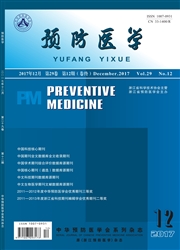

 中文摘要:
中文摘要:
目的分析社区2型糖尿病(T2DM)患者代谢指标在夏冬季的变化情况,为改善社区糖尿病管理提供依据。方法采用分层整群随机抽样方法,抽取舟山市定海城区2个社区在册管理1年以上,且无并发症的T2DM患者129例,分别于6月和12月测量体重、腰围、血糖、血脂和血压水平,并比较各项代谢指标在夏冬季节的变化情况。结果 119例T2DM患者体重、腰围和体质指数冬季高于夏季(P〈0.05);冬季糖化血红蛋白(Hb A1c)、空腹血糖(FPG)和高密度脂蛋白胆固醇(HDL-C)水平分别为(7.97±2.47)%、(7.56±1.91)mmol/L和(1.41±0.36)mmol/L,均高于夏季的(7.12±1.70)%、(7.04±2.31)mmol/L和(1.25±0.36)mmol/L(P〈0.01);夏季和冬季总胆固醇(TC)平均值均为(4.37±0.95)mmol/L;夏季Hb A1c、FPG和血压的控制率分别为56.36%、59.66%和62.18%,均高于冬季的44.54%、45.38%和50.42%(P〈0.05)。结论舟山市城市社区T2DM患者的代谢指标水平和控制率受季节影响,建议在冬季加强T2DM患者各项代谢指标的监测和管理。
 英文摘要:
英文摘要:
Objective To analysis the metabolic index among diabetic patients in community in summer and winter,and to provide evidence for disease management. Methods During June and December,119 diabetic patients were seleted from communities living for more than a year by the method of stratified cluster sampling. The metabolic indexes were compared using paired t test,and the rate of biochemical indicators were analyzed by Mc Nemar ' s test between two seasons. Results The values of Hb A1 c,GLU and HDL- C were higher in winter than in summer( P〈0. 01). The mean values of TC in summer and winter were the same. The detection values of triglyceride and low density lipoprotein were lower in winter than in summer,but the difference was not statistically significant( P〉0. 05). The control rate of Hb A1 c was 56. 36% in summer,and the control rate was 44. 54% in winter,the difference was statistically significant( P〈0. 05). In summer,the control rate was 59. 66%,higher than 45. 38% in winter,and the difference was statistically significant( P〈0. 05).The control rate of blood pressure was better than that in winter,while triglyceride and low density lipoprotein control was better than that in summer,but which was not statistically significant( P〉0. 05). Conclusion The metabolic index of diabetic patients in Zhoushan urban community was significantly affected by seasonal changes. Most indexes were better in summer than that in winter,which suggested that the intervention of diabetics should be enhanced in winter.
 同期刊论文项目
同期刊论文项目
 同项目期刊论文
同项目期刊论文
 期刊信息
期刊信息
